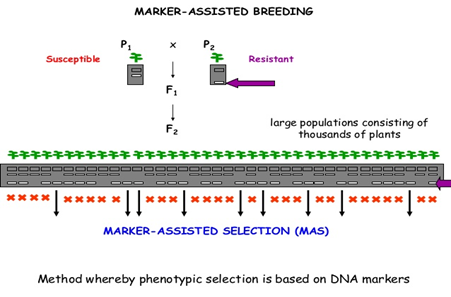Authors: 1*Pradeep Kumar Jatav, 1Nalla Manoj Kumar, 1Gururaj B. Matapathi, 1Arvind Nagar and 2Shisa ullas
1Division of Vegetable science, ICAR- IARI, New Delhi
2Division of Floriculture and Landscaping, ICAR- IARI, New Delhi
*Correspondence address: pradeepkaroriya500@gmail.com
To improve plant varieties, since the late 19th century plant breeders relied on phenotypic selection of traits such as plant morphological traits, disease resistances, yield and quality traits. Which is solely depends upon selection efficiency of a breeder for desired phenotype and demanding more time too.
Only with the advent of molecular markers in the late 1970s, it became possible to select desirable traits indirectly based on the banding pattern of marker instead of phenotype even at seedling stage which save time and labour cost, is termed as marker assisted selection. Easily detectable DNA markers can now be used in plant breeding. The idea of MAS or Smart Breeding was taken up with great enthusiasm, and several breeders expressed the hope to “skip several breeding cycles and condense timelines” and to finally having found a tool, “to control all allelic variation for all genes of agronomic importance”.
The DNA markers used for marker assisted selection must fulfil certain criteria such as marker must be close linked to gene of interest (<2cM), polymorphic nature of marker to differentiate between genotypes, high reproducibility, simple PCR procedure and cost effective.

Simple steps for MAS
- Selection of Parents: Both parents must have contrasting features or divergent in origin in order to identify the DNA of both parent and their segment in F2 population
- Development of breeding populations: This is second important step for MAS in which both selected parents are crossed to obtain F 1 plants. Different types of mapping population can be developed based of purpose. Generally 250 f2 plants are sufficient of MAS
- Isolation of DNA
- Genotyping: Genotyping is done based on polymorphism in marker between the parents and in F2 population.
- Correlation with morphological traits: The genotyping data is compared with phenotypic data and the indirect selection through molecular markers is confirmed. Once the correlation of molecular markers is established with morphological markers, MAS can be effectively used for genetic improvement of various economic traits.
Applications of Marker Assisted Selection (MAS):
- It is very effective, efficient and rapid method for transferring resistance to biotic and abiotic stresses in vegetable crops
- It is used for evaluation of breeding material for assessment of varietal purity and variety identification for DUS testing
- It is being used for transferring male sterility into cultivated genotypes from different sources for hybrid seed production and also for improvement of quality characters such as for protein quality in garden pea, and storage quality in other vegetable crops
- It is very useful in gene pyramiding for disease and insect resistance
- It can be successfully used for transferring desirable transgene from one cultivar to another
- It helps in Introgression of desirable genes from wild species to cultivated genotypes
- Early generation marker assisted selection
- Gene tagging
Advantages of Marker Assisted Selection (MAS):
- Accuracy: The high accuracy of MAS is because selection of desired traits is based on molecular markers which are independent of environmental conditions and hence, are effective in selection of low heritable characters.
- Rapid method: 3-5 years are sufficient for developing a new variety as compared to conventional breeding methods which take 10-15 years.
- Non-transgenic product: the varieties developed through MAS are not transgenic. Hence, accepted by the society.
- Identification of recessive alleles: MAS helps in identification of recessive alleles even under heterozygous conditions and thus, speeds crop improvement programmes.
- Early detection of traits: It permits early detection of traits which expressed at later stage of plant development. For example anthracnose in tomato occurs at fruiting stage can be selected at seeding stage in nursery.
- Screening low heritable and complex traits like biotic (insects and diseases) and abiotic stresses (drought, salinity, heat, frost etc.) is easy through MAS.
- Gene Pyramiding: MAS is very effective method in accumulating multiple genes for resistance to specific pathogens and pests within the same cultivar. This process is called gene pyramiding. Maker assisted backcrossing is routinely applied in breeding programmes for gene introgression.
- Small sample for testing: MAS requires only a small amount of plant tissue for DNA testing.
- Permits QTL Mapping: MAS permits mapping or tagging of quantitative trait loci (QTL) which is not possible by conventional method.
- Highly reproducible: The MAS is based on DNA fingerprinting technique and the results of DNA fingerprinting pattern are highly reliable and reproducible.
Limitations of Marker Assisted Selection (MAS):
- it is a costly method which requires well equipped laboratory, expensive equipments and chemicals
- Marker assisted selection results may not be published as MAS is always combined with conventional breeding methods
- MAS requires well trained manpower to handle the equipments, isolation of DNA and study of DNA markers
- Insufficient linkage between marker and gene/QTL
- The detection of various linked DNA markers is a difficult, laborious and time consuming task
- Effect of genetic background
- MAS sometimes involve use of radioactive isotopes which may lead to serious health hazards.
- The use of MAS is more difficult for QTL because they have minor cumulative effects and are greatly influenced by environmental conditions and genetic background.
About Author / Additional Info:
Ph.D. (Scholar), Vegetable science division, Pusa Campus, IARI, New Delhi